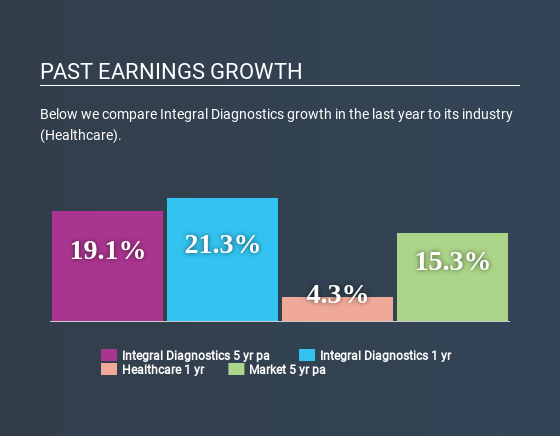Integral Diagnostics Limited's (ASX:IDX) Stock Is Going Strong: Have Financials A Role To Play?

Integral Diagnostics''s (ASX:IDX) stock is up by a considerable 63% over the past three months. As most would know, fundamentals are what usually guide market price movements over the long-term, so we decided to look at the company's key financial indicators today to determine if they have any role to play in the recent price movement. In this article, we decided to focus on Integral Diagnostics' ROE.
Return on equity or ROE is an important factor to be considered by a shareholder because it tells them how effectively their capital is being reinvested. In short, ROE shows the profit each dollar generates with respect to its shareholder investments.
View our latest analysis for Integral Diagnostics
How Do You Calculate Return On Equity?
ROE can be calculated by using the formula:
Return on Equity = Net Profit (from continuing operations) ÷ Shareholders' Equity
So, based on the above formula, the ROE for Integral Diagnostics is:
9.4% = AU$21m ÷ AU$226m (Based on the trailing twelve months to December 2019).
The 'return' refers to a company's earnings over the last year. Another way to think of that is that for every A$1 worth of equity, the company was able to earn A$0.09 in profit.
Why Is ROE Important For Earnings Growth?
We have already established that ROE serves as an efficient profit-generating gauge for a company's future earnings. We now need to evaluate how much profit the company reinvests or "retains" for future growth which then gives us an idea about the growth potential of the company. Assuming all else is equal, companies that have both a higher return on equity and higher profit retention are usually the ones that have a higher growth rate when compared to companies that don't have the same features.
Integral Diagnostics' Earnings Growth And 9.4% ROE
On the face of it, Integral Diagnostics' ROE is not much to talk about. However, given that the company's ROE is similar to the average industry ROE of 11%, we may spare it some thought. On the other hand, Integral Diagnostics reported a moderate 19% net income growth over the past five years. Given the slightly low ROE, it is likely that there could be some other aspects that are driving this growth. For instance, the company has a low payout ratio or is being managed efficiently.
As a next step, we compared Integral Diagnostics' net income growth with the industry, and pleasingly, we found that the growth seen by the company is higher than the average industry growth of 4.6%.
The basis for attaching value to a company is, to a great extent, tied to its earnings growth. The investor should try to establish if the expected growth or decline in earnings, whichever the case may be, is priced in. By doing so, they will have an idea if the stock is headed into clear blue waters or if swampy waters await. Is IDX fairly valued? This infographic on the company's intrinsic value has everything you need to know.
Is Integral Diagnostics Efficiently Re-investing Its Profits?
The high three-year median payout ratio of 77% (or a retention ratio of 23%) for Integral Diagnostics suggests that the company's growth wasn't really hampered despite it returning most of its income to its shareholders.
Besides, Integral Diagnostics has been paying dividends over a period of four years. This shows that the company is committed to sharing profits with its shareholders. Upon studying the latest analysts' consensus data, we found that the company is expected to keep paying out approximately 64% of its profits over the next three years. Still, forecasts suggest that Integral Diagnostics' future ROE will rise to 17% even though the the company's payout ratio is not expected to change by much.
Conclusion
Overall, we feel that Integral Diagnostics certainly does have some positive factors to consider. Namely, its high earnings growth. We do however feel that the earnings growth number could have been even higher, had the company been reinvesting more of its earnings and paid out less dividends. We also studied the latest analyst forecasts and found that the company's earnings growth is expected be similar to its current growth rate. Are these analysts expectations based on the broad expectations for the industry, or on the company's fundamentals? Click here to be taken to our analyst's forecasts page for the company.
This article by Simply Wall St is general in nature. It does not constitute a recommendation to buy or sell any stock, and does not take account of your objectives, or your financial situation. We aim to bring you long-term focused analysis driven by fundamental data. Note that our analysis may not factor in the latest price-sensitive company announcements or qualitative material. Simply Wall St has no position in any stocks mentioned.
Have feedback on this article? Concerned about the content? Get in touch with us directly. Alternatively, email editorial-team@simplywallst.com.

 Yahoo News
Yahoo News 

